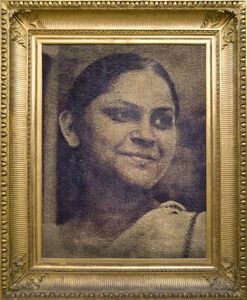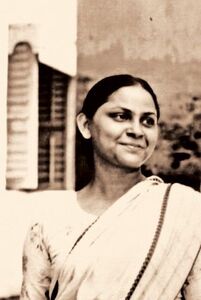I first met Nandini when I was in the third year in college. And fell in love with her. She was Durga who came down to earth.
When I told this to my mother she laughed and said that she will tell Nandini and with that added that Satyajit Ray’s first choice of Sarbojaya in Pather Panchali was Nandini. But alas D K Gupta did not want her to act.
In 1943, Ray started work at D.J. Keymer, a British-run advertising agency, as a "junior visualiser". Later, Ray also worked for Signet Press, a new publishing house started by D. K. Gupta. Gupta asked Ray to create cover designs for books to be published by Signet Press and gave him complete artistic freedom. Ray designed covers for many books, including children's version of Pather Panchali, a classic Bengali novel by Bibhutibhushan Bandyopadhyay, renamed as Aam Antir Bhepu ,The mango-seed whistle. Designing the cover and illustrating the book, Ray was deeply influenced by the work and was encouraged by D K Gupta to make a film.
During the course of his work he had met Nandini, the beautiful wife of DK Gupta who helped him with his work and had proposed that she act in Pather Panchali.
My father had died, and for a short span of time I tried to run his antiquarian firm. During this time I was interviewed in The Statesman by the editor N J Nanporia, and at a young age become quite a hero in the College Street para. Nandini read the interview and wanted to meet me. She told my mother what a young brave kid I am to get into the world of books and wanted to come home. I went over to meet her at their two storied Ekbalpur house, set against a small playing field.
It is here that I saw Durga decending on earth. I am Aloke. She replied: I am Nandini. That is how it was. I called her by her first name and we became friends. My mother objected to my calling her by her first name but Nandini did not mind. I am happy I was not introduced to her by my mother, as she would have complied with the convention of making it Nandini Masi. Our common platform was Books and Bookshops. I was fledging to get Kumars, my father’s antiquarian firm working. Nandini was trying her best to keep Signet Press alive and kicking. We were both passionate.
She came from the world of Jibanananda Das's Banalata Sen, and Rupasi Bangla, Bibhutibhushan Bandyopadhyay’s Pather Panchali. I came from Andre Gide’s Symphony Pastoral and Charles Baudelaire’s Au Lecteur . She spoke of Bengali literature , I spoke of French. She recited Jibananada I recited Baudelaire.
I remember when I had gone to her residence, I sat down at a wooden table near the stairwell, Nandini Gupta walks into the room, carrying a large stack of books. She takes a seat across from me and begins to tell me about the early days of Signet Press.
When D K Gupta began publishing with Signet Press, the process of printing books was almost as painstaking a task as crafting furniture from scratch. Each word of a book had to be typeset by hand and each page printed manually using the antique printing presses that now sit at the back of the building.
“At that time, printing was done with letterpress — that is, little lead letters that were raised — and the top of the letters got [brushed with] ink, and then that ink got pushed into the top of the paper,” Nandini explained.
Many years latter Signet Press shifted to photo-offset lithography machine, which allowed images to be transferred photographically to aluminium printing plates. Oil-based ink adhered to the images on the plates, which were then used to print the pages of a book.
In the 1960s offset lithography was introduced; a tremendous step forward in the publishing industry because it “drastically liberated” the process of creating printing plates. But the text of a book still had to be typeset by hand, which left publishers relatively restricted in other areas of design. As Nandini thumbs through additional books that were printed using offset lithography, she laughs and points out that they are all now backdated and out of print.
She showed me a book that Signet Press printed in 1947, The Discovery of India the dust cover of which was designed by Satyajit Ray. More importantly it was she who had shown the first galley proof of the Discovery to Jawaharlal Nehru for his approval.
Soon thereafter I realised that to be an antiquarian you needed a vast knowledge of many subjects, otherwise best you could be a collector of old books. People from across the world connected with you for advice on many subjects and the books they could refer. You have to help them to search out specific books, maps and prints. It was not easy. I decided to quit and started searching for a job.
I joined Rediffusion Advertising. Nandini came visiting me at my office in Russel Street and everybody was aghast. My boss, Subhas Chakraborty, who could recognise her went into a tizzy. It was an open office, and seeing her coming in, he got up to offer her a chair. The whole office rose to the occasion, not knowing what to do. She was completely at home having seen many a campaign of Bata being worked out of her home. She even suggested a change in a Bengali headline for a copy which the agency had been struggling all day.
I quit the revival of Kumars. Nandini did not . She continued her passion with Signet. She knew her subject. She wanted Signet Press to be limited edition Bengali publisher. She wanted Signet Press to be at the forefront of technological innovations in publishing and printing as in earlier days when it printed the works of many famed Bengali authors, including Bibhutibhushan Bandopadhyay, Jibanananda Das, Abanindra Nath Tagore and Satyajit Ray. D K Gupta himself was honoured with a slew of awards recognizing his contribution to the field of book art, including membership to the International Book Printer’s Association and Penrose.
Our relation continued. She was fond of theatres and I took her to the Academy of Fine Arts to see Ajitesh’s Tin Poishar Pala. She went on fidgeting in the seat and suggested changes. She narrated to me D K ‘s involvement in the theatre and told me that as the group Harabala went on with their production with Kamalkumar Majumdar, as the director and Sunil Gangopadhyay, Deepak Majumdar as actors, she was there in the wings to play a big role in the production .
In 1981 I joined the Anandabazar Group and we started to drift. Whatever the reason. Pressure of my work. My name and fame on the launch of The Telegraph for which I handled the research and design. I do not know. I kept in touch in a cursory way and there ended the story.
Only recently I felt from inside to get in touch with her. I went to the Ekbalpur house to find that it has been pulled down. I stood in front of the house with the sun fading and found a part of my life below the debris. The next day morning I went to the University and after class went down to Signet Book Shop. I came to know that it has changed hands and Anandabazar group is now the owner. I went over to Ananda Publisher to meet my old colleague Subir Mitra to get Nandini’s phone number.
I called her on her land line. The so close a voice of Nandini floated through. She told me that she is not well. She has always been suffering from asthma which has taken a toll. I wanted to see her. She laughed. She promised to call when she is slightly better. The call did not come.
I came to know that she had sold the collection of books of D K Gupta and had come to stay with her daughter Indrani, in Ballygunj with her disabled son whom she has taken care of all her life.
I read the news of her death in today’s Anandabazar and sobbed like a child. I was reminded of Satyajit Ray’s Debi where Umaprasad comes outside to find Doyamoyee, the Goddess running away into a field and vanishing into the mist.
My Durga has returned to Kailash.


